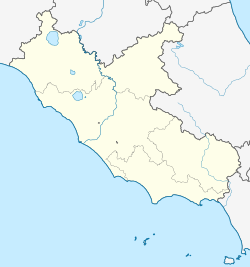Sant'Apollinare
Sant'Apollinare | ||
|---|---|---|
Comune | ||
| Comune di Sant'Apollinare | ||
| ||
Location of Sant'Apollinare | ||
 Sant'Apollinare Location of Sant'Apollinare in Italy Show map of Italy  Sant'Apollinare Sant'Apollinare (Lazio) Show map of Lazio | ||
| Coordinates: 41°24′N 13°50′E / 41.400°N 13.833°E / 41.400; 13.833 | ||
| Country | Italy | |
| Region | Lazio | |
| Province | Frosinone (FR) | |
| Government | ||
| • Mayor | Enzo Scittarelli | |
| Area | ||
| • Total | 17.0 km2 (6.6 sq mi) | |
| Elevation | 51 m (167 ft) | |
| Population (28 February 2017[1]) | ||
| • Total | 1,883 | |
| • Density | 110/km2 (290/sq mi) | |
| Demonym(s) | Santapollinaresi | |
| Time zone | UTC+1 (CET) | |
| • Summer (DST) | UTC+2 (CEST) | |
| Postal code | 03048 | |
| Dialing code | 0776 | |
| Website | Official website | |
Sant'Apollinare (locally Santapunaro or Santapunare) is a comune (municipality) in the Province of Frosinone in the Italian region Lazio, located about 120 kilometres (75 mi) southeast of Rome and about 50 kilometres (31 mi) southeast of Frosinone.
Sant'Apollinare borders the following municipalities: Cassino, Pignataro Interamna, Rocca d'Evandro, San Giorgio a Liri, Sant'Ambrogio sul Garigliano, Sant'Andrea del Garigliano, Vallemaio.
The town originated in 797, when Gisulf, abbot of Montecassino, created here a small monastic community. In the Middle Ages it had a castle commanding the Liri-Garigliano valley, now in ruins. It became part of the Lazio region in 1927. Due to its position across the Gustav Line, during World War II it suffered relevant destructions.
References
^ All demographics and other statistics: Italian statistical institute Istat.
External links
- Official website
- Sant'Apollinare's cemetery
This Lazio location article is a stub. You can help Wikipedia by expanding it. |
